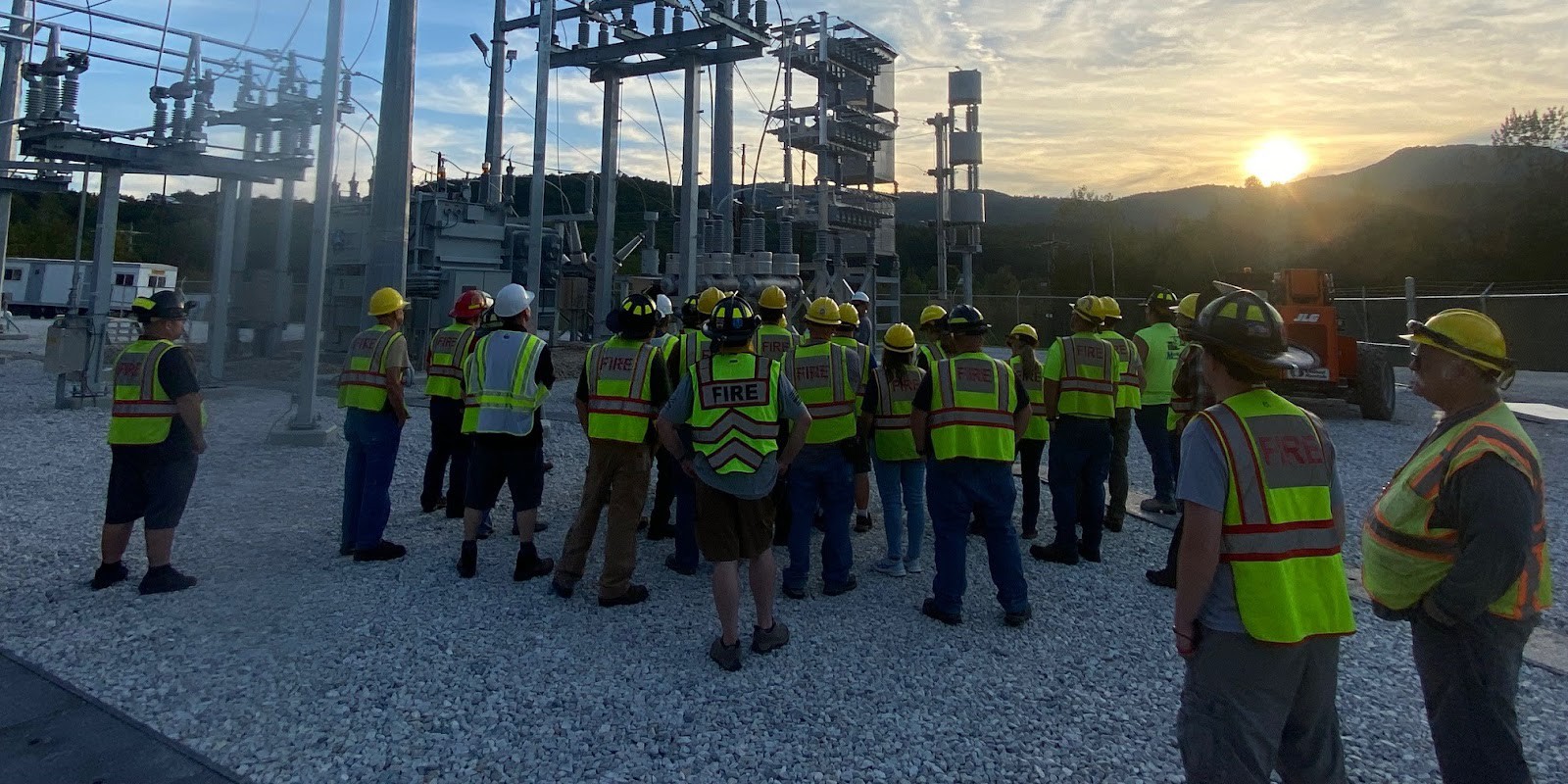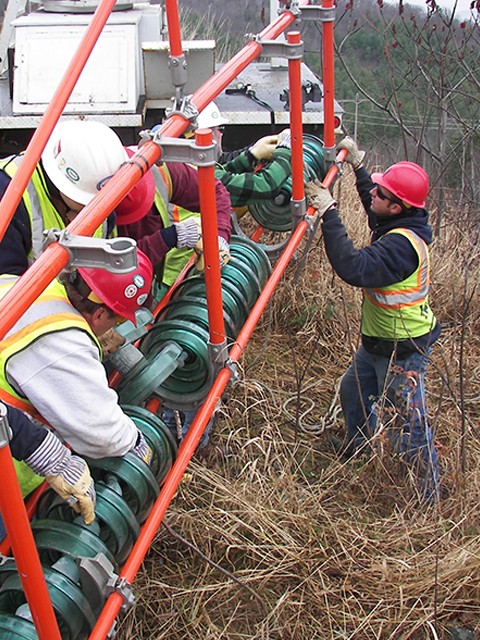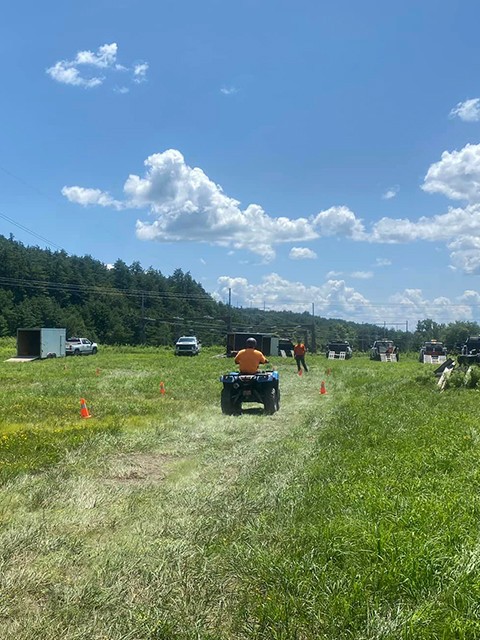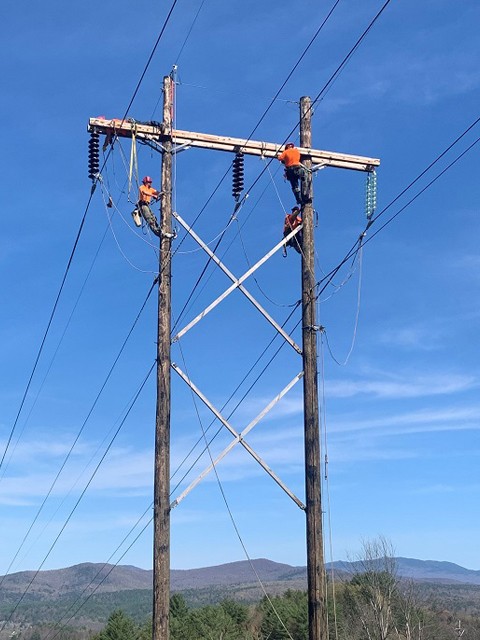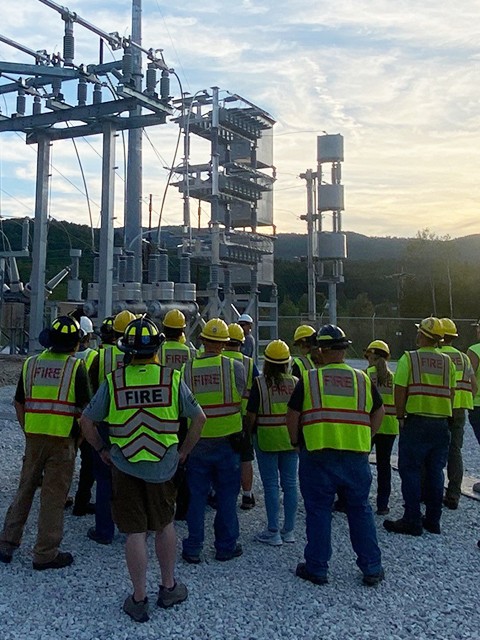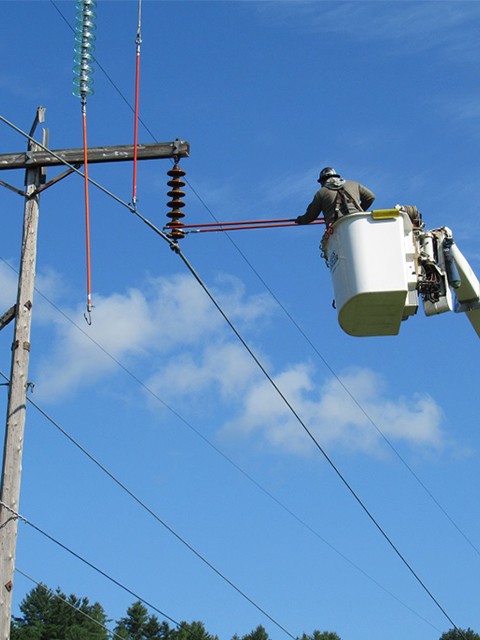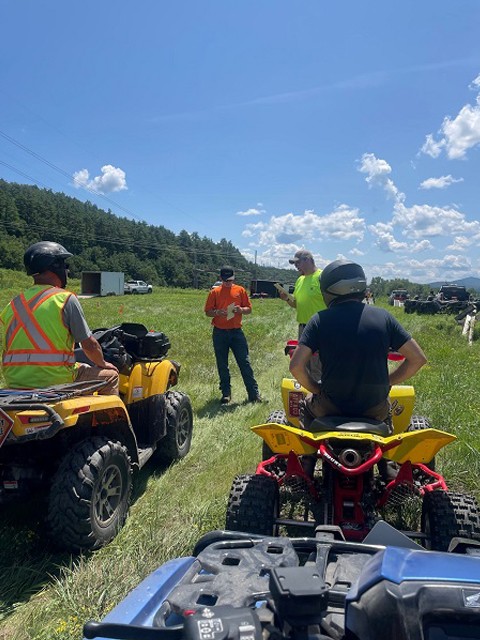Safety near transmission lines
Vermont is a very rural state and transmission lines frequently cross remote areas. Extreme care must be taken when working on land near transmission lines and structures. High-voltage lines are typically not insulated, and they carry enough energy to cause fatal injuries. Recognize the dangers and act responsibly. The best way to avoid injury from power lines is to make a personal commitment to the safety of yourself and others.
Essential safety precautions
- Stay clear of high-voltage overhead power lines.
- Don’t climb or attach anything to transmission structures.
- Know the layout of the overhead electrical network on and near your property.
- Always look up before moving or using tools or equipment such as irrigation pipe, ladders or cranes that may come in contact with overhead power lines.
- Federal and state laws require you to stay a safe distance of 15 feet or more away from overhead power lines of 100,000 volts or less while working. This 15-foot clearance applies to anything you may be carrying or using.
- Use spotters when operating lift trucks and power or farm equipment to avoid contacting overhead lines. The spotter should observe the work and communicate with the operator to ensure the equipment never gets closer than 15 feet to a transmission line.
- Recognize the dangers and act responsibly.
For more information and for safety assistance around power lines, call 802-770-6213.
VELCO high voltage transmission lines and fiber optics cross many Vermont farms. Our transmission lines meet National Electrical Safety Code clearances designed to protect line workers and the general public, however, farmers still need to exercise precautions when working under and near energized power lines. By making your family and workers aware of potentially dangerous electrical situations, you can help prevent serious injuries or death.
Look up & save your life
First, be aware of your surroundings and the height of your farm equipment when working in the transmission right-of-way (ROW). Unlike the wiring in a home, overhead power lines are not wrapped in electrical insulating material. Electrocution is the most significant risk from contacting or even coming close to a transmission line. Since electricity carried by high-voltage lines can arc across air space, electrical contact between an object on the ground and an energized wire can happen even though the two do not actually touch. Avoid bringing yourself, or any object you are driving or holding, too close to an overhead power line. Even non-metallic materials, such as lumber, tree limbs, tires, ropes, straw and hay, are capable of conducting electricity.
Many agricultural machines are large enough to contact an overhead transmission or fiber optic line, such as, combine harvesters, fork lift trucks, telescopic material handlers, antennas on trucks, self propelled harvesters, crop sprayers, tractors, excavators and diggers. Always lower equipment before you move it, even if you are only moving a few feet. Use caution raising dump trailers and keep truck bodies in a horizontal position when traveling within the ROW. Have someone be a spotter to double check your clearance from a distance away. Remember your visibility to judge distances decreases at dusk.
Crop height
VELCO has acquired easement rights to construct, operate and maintain power lines, and to keep the ROWs clear of all structures, fire hazards, vegetation, and any other use that may pose a safety risk or interfere with the reliability of our transmission system. Although most crops less than 12-feet tall can be grown safely under power lines, owners of established orchards, Christmas tree farms, and trellised crops should contact VELCO to confirm maximum allowable growth heights. If you are considering converting an open field to any one of these uses within a VELCO ROW, you will need to apply for authorization from VELCO’s Real Estate & ROW Department. If approved, you will also need to plan access routes for our crews’ use to perform routine maintenance on the poles and wires without damaging your crops.
Organic farms
Since VELCO’s Vegetation Management program includes, among other things, the selective use of herbicides in certain areas, please notify us if you have or plan to register as an organic farm. If you have questions regarding our use of herbicides as part of our vegetation management program, please contact VELCO.
Shock, water & smoke hazards
Under certain conditions, non-hazardous nuisance shocks can occur when touching metal objects near the transmission line, but away from the high-voltage wires. The shocks are caused by a voltage induced from the transmission lines into nearby metallic objects, like vehicles, fences, metal buildings or roofs, and irrigation systems that are near the line or parallel the line for some distance. The shock can resemble touching the spark-plug ignition wires on your lawnmower or car.
Refueling vehicles is also not allowed on rights-of-way because there is a chance that a spark from an induced voltage could ignite the fuel.
Farming safely around high-voltage electric lines
Electricity can be conducted through water, so never allow an irrigation system to spray a continuous stream onto power lines or pole structures. Position rain and slurry guns so that jets of water or slurry cannot contact the overhead lines when they are in use, and remember, high winds should be taken into account.
Smoke and hot gases from a large fire can create a conductive path for electricity. When a fire is burning under a transmission line, electricity could arc from the wire through the smoke and to the ground, endangering nearby people and objects.
Right-of-way uses & unauthorized encroachments
VELCO will consider landowner requests to use our right-of-way, but only if they do not cause a safety or operational risk. We have developed guidelines for these conditional uses that may be considered and approved by VELCO engineers and managers. Some examples of non-permitted uses in the easement area include, but are not limited to, buildings, swimming pools, signs, grade changes, drainage ditches, slurry ponds, storage buildings, and fences or walls that might unreasonably obstruct our access, or pose a safety risk. For more information, visit www.velco.com/real-estate-and-right-of-way.
General safety
For your safety, do not fly kites or model airplanes near the ROW, do not climb or attach anything to transmission poles, never touch a fallen wire, never shoot at transmission facilities—gunshot can cause flashovers or may cause the wire to fall to the ground and is a violation of federal law. Please help us keep our rights-of-way safe, and our service reliable by reporting any unusual activity or condition.
Make sure everyone on your farm knows what to do in the event of an emergency. If equipment you are operating contacts the transmission line, do NOT get off the machinery unless you are in immediate danger. Call 911 and VELCO immediately. Electrocution is possible if anyone touches both the machine and the ground at the same time. If you must leave the equipment, land with feet together and arms close to your body. Keep your feet touching each other and shuffle away from the machinery or fallen wire – do not run. Do not go back for any reason until VELCO has informed you that the area is safe.
If you have damaged a guy wire, pole or any buried wires, please call VELCO immediately so we can reinstall the wires.
For more information on power line safety, or to report an unusual condition or suspicious activity, please contact VELCO at 802.770.6357.
Logging or tree cutting near any power line can be very hazardous and requires special caution. Please contact VELCO prior to logging or cutting near the transmission lines. Since trees conduct electricity, if one should fall into or close to a transmission line, the current could follow the tree trunk to the ground and endanger anyone standing near its base. If you come upon a tree that has fallen into a power line, stay away from it and call 911 and VELCO or the local distribution utility immediately.
Hazardous nuisance shocks can occur when touching objects, like vehicles, tool boxes, fences, metal buildings or roofs that are near the line or parallel the line for some distance. Keep all logging activities out of the utility corridors.
VELCO high-voltage transmission lines and fiber optics cross many Vermont properties. Our transmission lines meet National Electric Safety Code clearances and are designed to protect line workers and the general public. However, loggers still need to exercise precautions when working under and near energized power lines.
By making your company and workers aware of potentially dangerous electrical situations, you can prevent serious injuries or death.
VELCO’s high-voltage lines run through Vermont’s farms, forests and fields. Our power lines are built to standards that protect line workers and the public. Still, when you walk, hunt or bike near transmission lines, you must play your part to be safe. Simple precautions will prevent serious injury and property damage.
Because game and other wildlife use our rights-of-way, we know sportsmen, sportswomen and other outdoor enthusiasts want to use them too. Here are safety hazards and other things you need to know before entering a transmission line corridor.
General safety
- DO NOT fly kites, model airplanes, nor drones near the power lines.
- DO NOT climb or attach anything to transmission poles, including deer stands, climbing steps or blinds.
- DO contact VELCO before building any structure in the right-of-way as it may risk electric reliability and safety.
- DO report anything unusual you observe to help us keep our lines safe and service reliable.
Guns & power lines
Shooting at transmission facilities—wires, poles, and insulators—is dangerous to you, jeopardizes everyone’s power, and is a federal crime. A gunshot can make electricity arc to the ground or cause the wire to fall, with a high risk of serious injury or death. Never attempt to shoot through the wires or at anything that may be on the wires or poles.
Responsible, ethical and safe hunters will always consider the environment where they are hunting. Make sure of your target, and what is in front and beyond it. If your target is “sky lined” on a hill or power line and you cannot see what lies beyond, do not take the shot.
Shock & smoke hazards
- Shocks—about as intense as touching the spark-plug wires of your lawnmower or car—can come from the power lines to nearby metallic objects, like vehicles, fences, metal buildings or roofs. You can avoid shocks by grounding the metallic objects.
- If possible, avoid refueling vehicles directly under transmission lines, because there is a chance that a spark from an induced voltage could ignite the fuel.
- Fires are not allowed under a power line. Smoke and hot gases from a large fire can create a path for electricity to arc from the wire endangering nearby people and objects.
Land ownership & access
VELCO usually owns an easement under its power lines and for its access roads, rather than owning the land itself. The easements allow us to build and maintain the power line. Where we don’t own the land, we can’t give permission to trespass on the right-of-way. We encourage hunters to respect landowner rights and to seek permission before entering the corridor. Visit Vermont Fish & Wildlife to learn more about seeking landowner permission for access and Vermont All-Terrain Sportsman's Association or Vermont Association of Snow Travellers to learn more about all-terrain vehicle trails.
LOOK UP AND SAVE YOUR LIFE
Occupational Safety & Health Administration (OSHA)Minimum Safe Working Distances from Exposed EnergizedParts (including overhead lines) for Non-Qualified Personnel | |
Nominal Voltage Phase-to-Phase (V) | Minimum Working Distance in Feet |
0 to 50,000 | 10 |
Over 50,000 to 200,000 | 15 |
Over 200,000 to 345,000 | 20 |
| As voltage increases, the need for greater clearance from the power source, also increases. Consult OSHA regulations for further workplace safety guidance: www.osha.gov | |
Follow the guidelines provided in OSHA's Overhead Power Line Safety Standard.
Never store materials (logs, limbs, whole trees etc.), or place yarding/landing areas under or near overhead power lines.
Avoid bringing yourself, or any object you are driving or holding, too close to an overhead power line. Even non-metallic materials, such as lumber, tree limbs, tires, ropes, straw and hay, are capable of conducting electricity.
If a vehicle/machine makes accidental contact with an overhead line, DO NOT allow anyone to come near or touch the machine. Stay away from the machine and summon outside assistance. Once you get away from the equipment, never attempt to get back on or even touch the equipment.
If the driver must leave the vehicle, he must jump out, keeping his feet together and arms close to his body. He must keep feet touching each other—shuffle away from the machinery—do not run.
If you encounter a downed power line, stay at least 100 feet away and leave the area. Immediately call 911 and your local utility. Do not go back for any reason until the utility company has safely disconnected and de-energized the line.
If you have accidently damaged any part of a transmission facility—wires, poles, and insulators—please call VELCO immediately so we can inspect and repair the damage. For more information on power line safety, or to report anything unusual or suspicious, please contact VELCO at 802.770.6261
We support first responders and other emergency personnel response to fires and other emergencies involving electric utility lines and facilities. Firefighters, police and EMTs are typically the first on the scene in an emergency, and therefore face the greatest risk when responding to emergencies where electric utility lines and facilities are involved. Available below are safety guidance and training resources to emergency services personnel to mitigate those risks and ensure best practices are implemented during an emergency.
Training opportunities
- VELCO offers in-person and virtual training to first responder teams. Please contact us here to find out more information.
Safety resources
- Procedures for first responders (Recording: March 24, 2021 Safety Training)
- First Responder Utility Safety Presentation: March 24, 2021 Safety Training
- VELCO Safety Manual
Other resources
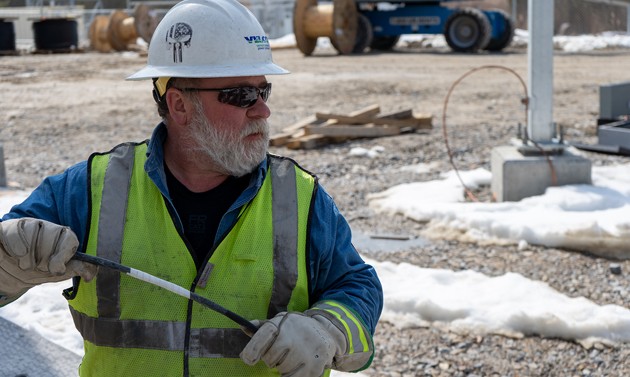
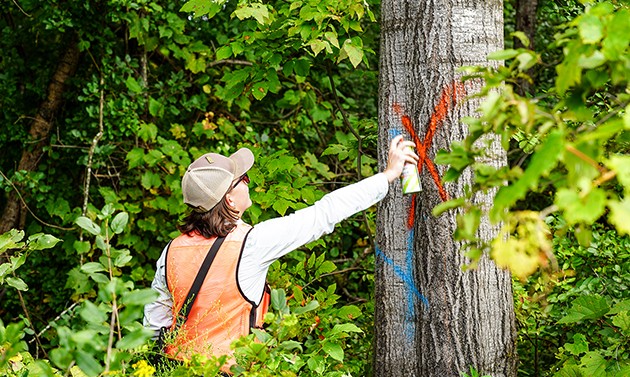
We value your feedback and inquiries. Please fill out the contact us form, and our dedicated team will promptly get in touch with you. Thank you for reaching out!
